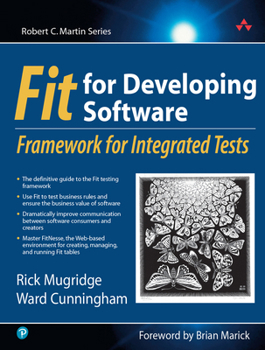Fit for Developing Software: Framework for Integrated Tests
(Part of the Robert C. Martin Series Series)
Select Format
Select Condition 
Book Overview
"The unique thing about Fit for Developing Software is the way it addresses the interface between customers/testers/analysts and programmers. All will find something in the book about how others wish to be effectively communicated with. A Fit book for programmers wouldn't make sense because the goal is to create a language for business-oriented team members. A Fit book just for businesspeople wouldn't make sense because the programmers have to be involved in creating that language. The result is a book that should appeal to a wide range of people whose shared goal is improving team communications."
--Kent Beck, Three Rivers Institute
"Even with the best approaches, there always seemed to be a gap between the software that was written and the software the user wanted. With Fit we can finally close the loop. This is an important piece in the agile development puzzle."
--Dave Thomas, coauthor of The Pragmatic Programmer
"Ward and Rick do a great job in eschewing the typical, overly complicated technology trap by presenting a simple, user-oriented, and very usable technology that holds fast to the agile principles needed for success in this new millennium."
--Andy Hunt, coauthor of The Pragmatic Programmer
"Florida Tech requires software engineering students to take a course in programmer testing, which I teach. Mugridge and Cunningham have written a useful and instructive book, which will become one of our course texts."
--Cem Kaner, Professor of Software Engineering, Florida Institute of Technology
"Rick and Ward continue to amaze me. Testing business rules is a fundamentally hard thing that has confounded many, and yet these two have devised a mechanism that cuts to the essence of the problem. In this work they offer a simple, thorough, approachable, and automatable means of specifying and testing such rules."
--Grady Booch, IBM Fellow
"By providing a simple, effective method for creating and automating tabular examples of requirements, Fit has dramatically improved how domain experts, analysts, testers, and programmers collaborate to produce quality software."
--Joshua Kerievsky, founder, Industrial Logic, Inc., and author of Refactoring to Patterns
"Agile software development relies on collaborating teams, teams of customers, analysts, designers, developers, testers, and technical writers. But, how do they work together? Fit is one answer, an answer that has been thoroughly thought through, implemented, and tested in a number of situations. Primavera has significantly stabilized its product lineusing Fit, and I'm so impressed by the results that I'm suggesting it to everyone I know. Rick and Ward, in their everlasting low-key approach, have again put the keystone in the arch of software development. Congratulations and thanks from the software development community."
--Ken Schwaber, Scrum Alliance, Agile Alliance, and codeveloper of Scrum
"Fit is the most important new technique for understanding and communicating requirements. It's a revolutionary approach to bringing experts and programmers together. This book describes Fit comprehensively and authoritatively. If you want to produce great software, you need to read this book."
--James Shore, Principal, Titanium I.T. LLC
"There are both noisy and quiet aspects of the agile movement and it is often the quieter ones that have great strategic importance. This book by Ward and Rick describes one of these absolutely vital, but often quieter, practices--testing business requirements. A renewed focus on testing, from test-driven development for developers to story testing for customers, is one of the agile community's great contributions to our industry, and this book will become one of the cornerstones of that contribution. Stories are done-done (ready for release) when they have been tested by both developers (done) and customers (done-done). The concepts and practices involved in customer story testing are critical to project success and wonderfully portrayed in this book. Buy it. Read it. Keep it handy in your day-to-day work."
--Jim Highsmith, Director of Agile Software Development & Project Management Practice, Cutter Consortium
"I have been influenced by many books, but very few have fundamentally changed how I think and work. This is one of those books. The ideas in this book describe not just how to use a specific framework in order to test our software, but also how we should communicate about and document that software. This book is an excellent guide to a tool and approach that will fundamentally improve how you think about and build software--as it has done for me."
--Mike Cohn, Mountain Goat Software, author of User Stories Applied
"Fit is a tool to help whole teams grow a common language for describing and testing the behavior of software. This books fills a critical gap--helping both product owners and programmers learn what Fit is and how to use it well."
--Bill Wake, independent consultant
"Over the past several years, I've been using Fit and FitNesse with development teams. They are not only free and powerful testing tools, they transform development by making the behavior of applications concrete, verifiable, and easily observable. The only thing that has been missing is a good tutorial and reference. Rick Mugridge and Ward Cunningham's Fit For Developing Software fits the bill. Essentially, two books in one, it is a very readable guide that approaches Fit from technical and nontechnical perspectives. This book is a significant milestone and it will make higher software quality achievable for many teams."
--Michael C. Feathers, author of Working Effectively with Legacy Code, and consultant, Object Mentor, Inc.
"Wow This is the book I wish I had on my desk when I did my





